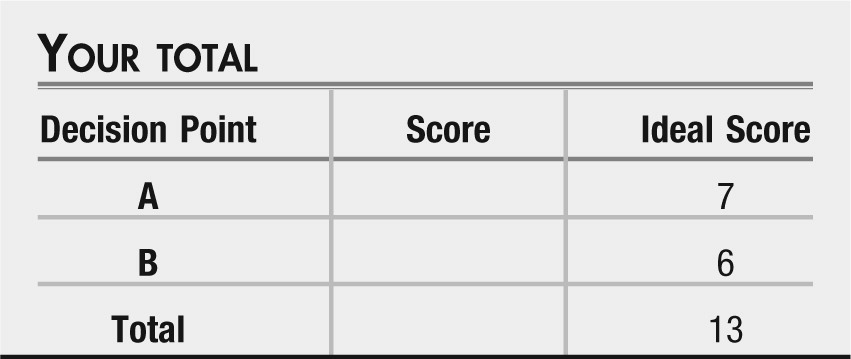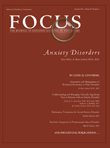Patient Management Exercise for Anxiety Disorders
Abstract
CASE VIGNETTE
Consideration Point A:
| A1._____ | Generalized anxiety disorder |
| A2._____ | Social anxiety disorder |
| A3._____ | Panic disorder |
| A4._____ | Substance use |
| A5._____ | Manic episode |
VIGNETTE CONTINUES
DECISION POINT B:
| B1._____ | Offer a trial of sertraline, starting at a low dose. |
| B2._____ | Refer her for cognitive behavior psychotherapy. |
| B3._____ | Offer a trial of alprazolam or clonazepam for as needed use. |
VIGNETTE CONCLUDES
ANSWERS: SCORING, RELATIVE WEIGHTS, AND COMMENTS
Decision Point A:
| A1._____ | +1 Generalized anxiety disorder. Although worry is a key element of the DSM-IV-TR criteria for generalized anxiety disorder, the abrupt onset of symptoms is not typical of this disorder. |
| A2._____ | +2 Social anxiety disorder. The patient's distress did begin while at a social function, and we do not yet know more of the details of the event, such as whether she felt exposed to public scrutiny or embarrassed as part of the “freaking out” experience. |
| A3._____ | +3 Panic disorder. The sudden onset of symptoms, the mixture of somatic complaints and a feeling of loss of control, and the benign findings in the ED would be consistent with a panic attack. At this point in your evaluation, it is unclear whether this was an isolated event or part of a more pervasive disorder. |
| A4._____ | +1 Substance use. Even though results of the urine toxicology screen were negative, it is possible that a patient may be using, or withdrawing from, a substance that is not detected by routine urine toxicology. |
| A5._____ | −2 Manic episode. Although feeling hyperkinetic is not uncommon in mania, the patient's prominence of somatic distress and the sudden onset over the course of minutes are not particularly consonant with the features or time course of most manic episodes. |
Consideration Point B:
| B1._____ | +3 Selective serotonin reuptake inhibitor (SSRI) pharmacotherapy. Controlled trials have supported the use of SSRI antidepressant medications in patients with panic disorder as first-line pharmacotherapy (1–3). Because patients with panic disorder can be sensitive to side effects, low starting doses are recommended, typically half of the starting doses given to depressed patients (3). A low dose should then be increased after several days to a full therapeutic dose over subsequent days/weeks as tolerated, because underdosing of antidepressants is a common source of partial response or nonresponse. |
| B2._____ | +3 Cognitive behavioral therapy (CBT). Published evidence supports the use of CBT as a primary treatment in panic disorder. CBT programs for panic disorder generally include elements of psychoeducation, self-monitoring, countering anxious beliefs, exposure to fear cues, modification of anxiety-maintaining behaviors, and relapse prevention measures. Exposure is often challenging but can be a key component of CBT for panic disorder. |
| B3._____ | −1 Alprazolam or clonazepam as needed. Both alprazolam and clonazepam have received a U.S. Food and Drug Administration indication for panic disorder. However, as APA Practice Guidelines Quick Reference Guide (3) describes, “When benzodiazepines are prescribed, a regular dosing schedule rather than a PRN (‘as needed’) schedule is preferred for patients with panic disorder. The goal is to prevent panic attacks rather than reduce symptoms once the attack has already occurred. (emphasis added)” |


REFERENCES
Information & Authors
Information
Published In
History
Authors
Funding Information
Metrics & Citations
Metrics
Citations
Export Citations
If you have the appropriate software installed, you can download article citation data to the citation manager of your choice. Simply select your manager software from the list below and click Download.
For more information or tips please see 'Downloading to a citation manager' in the Help menu.
View Options
View options
PDF/EPUB
View PDF/EPUBGet Access
Login options
Already a subscriber? Access your subscription through your login credentials or your institution for full access to this article.
Personal login Institutional Login Open Athens loginNot a subscriber?
PsychiatryOnline subscription options offer access to the DSM-5-TR® library, books, journals, CME, and patient resources. This all-in-one virtual library provides psychiatrists and mental health professionals with key resources for diagnosis, treatment, research, and professional development.
Need more help? PsychiatryOnline Customer Service may be reached by emailing [email protected] or by calling 800-368-5777 (in the U.S.) or 703-907-7322 (outside the U.S.).

